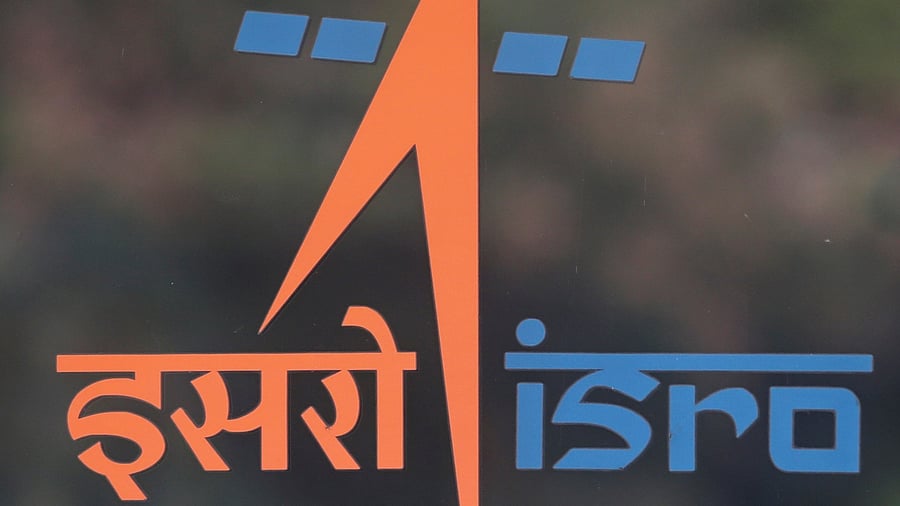
The logo of ISRO.
Credit: Reuters File Photo
In many ways, Group Captain Shubhanshu Shukla’s journey to the International Space Station in a couple of weeks is going to be different from Wing Commander Rakesh Sharma’s voyage four decades ago. Wing Commander Sharma’s 1984 journey to a Russian space station aboard a Russian spacecraft was considered a one-off activity not linked to the Indian Space Research Organisation’s core focus on using space for economic growth.
But, with ISRO now having an ambitious space exploration programme, Group Captain Shukla’s journey will play a key role in fine-tuning the Gaganyaan mission (human space flight programme) and shaping the ambitious scheme to have Bhartiya Antriksh Station (Indian Space Station) and an Indian on the Moon.
Consider the seven Indian experiments to be conducted during the AX-4 mission. One of them is on the use of computer screens in space. It will study how pointing tasks, gaze fixation, and rapid eye movements are affected in space and whether the screens influence the stress well-being of the astronauts. The output will be handy for the indigenous space station and sending an Indian to the Moon. Similarly, a few experiments aim at the future food choices of Indian astronauts and whether extended stay in space can have any impact on body muscles. These are clear signs of space aspirations.
The Axiom Mission 4 will “realise the return” to human spaceflight for India, Poland, and Hungary, with each nation’s first government-sponsored flight in more than 40 years, marking these countries' second human spaceflight mission in history.
A SpaceX Falcon 9 rocket will launch the Ax-4 crew aboard a Dragon spacecraft to the ISS from Launch Complex 39A at NASA’s Kennedy Space Centre in Florida. During their 14-day mission docked to the orbiting laboratory, the astronauts will conduct global outreach initiatives, microgravity research, and technology demonstrations, making it the most research-intensive Axiom Space mission to date. Unlike Rakesh Sharma’s Soyuz T-11 trip, which was a goodwill offer from the Soviet Union, India paid over $60 million for Group Captain Shukla’s spaceflight.
For years, Indian space programmes ran on the path charted by Vikram Sarabhai, who believed that the limited resources available should be used to solve ‘real problems of man and society’. So much so that even an MoU between India and Russia to send two Indian astronauts to space by 2013 was given a quiet burial. Till early August 2018, the government told Parliament that human space flight was not on the cards.
But things changed drastically within two weeks when Prime Minister Narendra Modi, in his 2018 Independence Day address, announced the plan to have an Indian in space by 2022 – the 75th anniversary of Independence. Within a year, Modi gave more tasks to the ISRO: Bharatiya Antriksh Station by 2035 and an Indian on the Moon by 2040, along with complex scientific missions like an orbiter around Venus and a sample return mission for the Moon.
Credit: Special arrangement
While technical challenges coupled with the Covid-19 pandemic delayed the Gaganyaan programme, the ISRO now has a target of launching the first human space flight mission by the first quarter of 2027. The space agency worked on 12 areas and perfected all the key technologies, which will now be put through a series of tests. The first uncrewed test will take place in December when a half-humanoid robot, Vyom Mitra, will travel to space to simulate human responses. Two more uncrewed missions will follow before the first set of Gaganyaatris go to space.
The maiden uncrewed test flight of Gaganyaan will be followed by the launch of the first module of the space station, which eventually will have five such modules. All of them will be launched separately, and they will join in space through a series of complex docking and undocking processes, which the ISRO hopes to master.
The space agency currently doesn’t have any plan to have astronauts stationed in the Indian space station, but that can change depending on the Gaganyaan’s success. Group Captain Shukla’s AX-4 mission will be the first stepping stone for India to join, in the near future, a very small league of nations which sent their citizens to space in their own rockets and space capsules and from their own soil.
